Spatial and Temporal Variation Characteristics of Stable Isotopes in Precipitation and Their Relationships with Meteorological Factors in the Shiyang River Basin in China
Abstract
:1. Introduction
2. Material and Methods
2.1. Study Area
2.2. Sampling Procedure
2.3. Methods
3. Results
3.1. Temporal Variation Characteristics of Stable Isotopes of Precipitation
3.1.1. Daily Variations
3.1.2. Monthly and Seasonal Variations
3.1.3. Interannual Variations
3.2. Spatial Variation Characteristics of Stable Isotopes of Precipitation
3.2.1. Spatial Variations of Stable Isotopes
3.2.2. Spatial Variations of the Local Atmospheric Waterline
4. Discussion
4.1. Relationship between Stable Isotopes in Precipitation and Temperature
4.2. Relationship between Stable Isotopes in Precipitation and Precipitation Amount
4.3. Relationship between Stable Isotopes in Precipitation and Relative Humidity
4.4. Relationship between Stable Isotopes in Precipitation and Water Vapor Pressure
5. Conclusions
Author Contributions
Funding
Data Availability Statement
Acknowledgments
Conflicts of Interest
References
- Yang, Q.; Mu, H.; Guo, J.; Bao, X.; Martín, J.D. Temperature and rainfall amount effects on hydrogen and oxygen stable isotope in precipitation. Quatern. Int. 2019, 519, 25–31. [Google Scholar] [CrossRef]
- Juan, G.; Li, Z.; Qi, F.; Ruifeng, Y.; Tingting, N.; Baijuan, Z.; Jian, X.; Wende, G.; Fusen, N.; Weixuan, D.; et al. Environmental effect and spatiotemporal pattern of stable isotopes in precipitation on the transition zone between the Tibetan Plateau and arid region. Sci. Total Environ. 2020, 749, 141559. [Google Scholar] [CrossRef]
- Kostrova, S.S.; Meyer, H.; Fernandoy, F.; Werner, M.; Tarasov, P.E. Moisture origin and stable isotope characteristics of precipitation in southeast Siberia. Hydrol. Process. 2020, 34, 51–67. [Google Scholar] [CrossRef]
- Shi, Y.; Jin, Z.; Wu, A.; Li, G.; Li, F. Stable isotopic characteristics of precipitation related to the environmental controlling factors in Ningbo, East China. Environ. Sci. Pollut. R. 2021, 28, 10696–10706. [Google Scholar] [CrossRef]
- Laonamsai, J.; Ichiyanagi, K.; Kamdee, K.; Putthividhya, A.; Tanoue, M. Spatial and temporal distributions of stable isotopes in precipitation over Thailand. Hydrol. Process. 2021, 35, e13995. [Google Scholar] [CrossRef]
- Kumar, U.S.; Kumar, B.; Rai, S.P.; Sharma, S. Stable isotope ratios in precipitation and their relationship with meteorological conditions in the Kumaon Himalayas, India. J. Hydrol. 2010, 391, 1–8. [Google Scholar] [CrossRef]
- Kurita, N.; Ichiyanagi, K.; Matsumoto, J.; Yamanaka, M.D.; Ohata, T. The relationship between the isotopic content of precipitation and the precipitation amount in tropical regions. J. Geochem. Explor. 2009, 102, 113–122. [Google Scholar] [CrossRef]
- Bowen, G.J. Spatial analysis of the intra-annual variation of precipitation isotope ratios and its climatological corollaries. J. Geophys. Res. Atmos. 2008, 113, D05113. [Google Scholar] [CrossRef]
- Pang, Z.; Kong, Y.; Froehlich, K.; Huang, T.; Yuan, L.; Li, Z.; Wang, F. Processes affecting isotopes in precipitation of an arid region. Tellus B 2011, 63, 352–359. [Google Scholar] [CrossRef]
- Lachniet, M.S.; Patterson, W.P. Oxygen isotope values of precipitation and surface waters in northern Central America (Belize and Guatemala) are dominated by temperature and amount effects. Earth Planet. Sci. Lett. 2009, 284, 435–446. [Google Scholar] [CrossRef]
- Bedaso, Z.; Wu, S.Y. Daily precipitation isotope variation in Midwestern United States: Implication for hydroclimate and moisture source. Sci. Total Environ. 2020, 713, 136631. [Google Scholar] [CrossRef]
- Peng, T.R.; Wang, C.H.; Huang, C.C.; Fei, L.Y.; Chen, C.T.A.; Hwong, J.L. Stable isotopic characteristic of Taiwan’s precipitation: A case study of western Pacific monsoon region. Earth Planet. Sci. Lett. 2020, 289, 357–366. [Google Scholar] [CrossRef]
- Araguás-Araguás, L.; Froehlich, K.; Rozanski, K. Stable isotope composition of precipitation over southeast Asia. J. Geophys. Res. Atmos. 1998, 103, 28721–28742. [Google Scholar] [CrossRef]
- Dansgaard, W. Stable isotopes in precipitation. Tellus 1964, 16, 436–468. [Google Scholar] [CrossRef]
- Craig, H. Isotopic variations in meteoric waters. Science 1961, 133, 1702–1703. [Google Scholar] [CrossRef]
- Du, K.; Zhang, B. Stable isotope characteristics of precipitation and sources of water vapor in the Pearl River Basin. J. China Hydrol. 2020, 40, 75–82. [Google Scholar]
- Xia, Z.; Winnick, M.J. The competing effects of terrestrial evapotranspiration and raindrop re-evaporation on the deuterium excess of continental precipitation. Earth Planet. Sci. Lett. 2021, 572, 117120. [Google Scholar] [CrossRef]
- Jeelani, G.; Deshpande, R.D.; Galkowski, M.; Rozanski, K. Isotopic composition of daily precipitation along the southern foothills of the Himalayas: Impact of marine and continental sources of atmospheric moisture. Atmos. Chem. Phy. 2018, 18, 8789–8805. [Google Scholar] [CrossRef]
- Wu, J.K.; Ding, Y.; Ye, B.; Yang, Q.; Zhang, X.; Wang, J. Spatio-temporal variation of stable isotopes in precipitation in the Heihe River Basin, Northwestern China. Environ. Earth Sci. 2010, 61, 1123–1134. [Google Scholar] [CrossRef]
- Li, Z.; Gui, J.; Wang, X.; Feng, Q.; Zhao, T.; Ouyang, C.; Shi, Y. Water resources in inland regions of central Asia: Evidence from stable isotope tracing. J. Hydrol. 2019, 570, 1–16. [Google Scholar] [CrossRef]
- Chen, H.; Chen, Y.; Li, D.; Li, W. Effect of sub-cloud evaporation on precipitation in the Tianshan Mountains (Central Asia) under the influence of global warming. Hydrol. Process. 2020, 34, 5557–5566. [Google Scholar] [CrossRef]
- Jia, W.; Xu, X.; Yuan, R.; Ma, X.; Zhu, G.; Li, Z. Variation characteristics of stable isotopes in precipitation and the environmental factors that influence them in the Shiyang River Basin of China. Environ. Earth Sci. 2019, 78, 306. [Google Scholar] [CrossRef]
- Ma, J.; Zhang, P.; Zhu, G.; Wang, Y.; Edmunds, W.M.; Ding, Z.Y.; He, J.H. The composition and distribution of chemicals and isotopes in precipitation in the Shiyang River system, northwestern China. J. Hydrol. 2012, 436, 92–101. [Google Scholar] [CrossRef]
- Yuan, R.; Jia, W.; Li, Z.; Xu, X.; Zhang, Z.; Shi, Y.; Yang, L.; Xiong, H. Regional differences in stable isotope changes of precipitation in the Shiyang River Basin. China Environ. Sci. 2020, 40, 4945–4956. [Google Scholar] [CrossRef]
- Gui, J.; Li, Z.; Feng, Q.; Zhang, D.; Lv, Y.; Yuan, R. Characteristics of runoff components in the Gulang River Basin, Qilian Mountains. J. Glaciol. Geocryol. 2019, 41, 918–925. [Google Scholar]
- Zhao, P.; Xu, X.; Qu, J.; Li, Y.; Jiang, S.; Zhang, Y. Hydrogen and oxygen isotope characteristics of atmospheric precipitation and water vapor sources in Qingtu Lake, lower Shiyang River. J. Arid Land Resour. Environ. 2019, 33, 80–85. [Google Scholar] [CrossRef]
- Xiong, H.; Jia, W.; Zhu, G.; Ma, X.; Xu, X.; Yuan, R.; Zhang, Z.; Shi, Y.; Yang, L. Influence of below-cloud secondary evaporation on stable isotope composition in precipitation and its relationship with meteorological factors in Shiyang River Basin, Northwest China. Environ. Earth Sci. 2021, 80, 255. [Google Scholar] [CrossRef]
- Gao, C.; Zhao, J.; Li, C.; Wei, W.; Wang, J.; Kang, C. Grassland cover and its ecological service function changes in Shiyang River Basin. Pratacultural. Sci. 2019, 36, 27–36. [Google Scholar]
- Huang, J.; Zhou, J.; Dou, J.; Ma, D.; Zhao, X.; Wei, W.; Hu, K. Extreme precipitation variability and its influencing factors in the monsoon marginal zone—A case study of Shiyang River Basin. Chin. J. Ecol. 2022, 41, 536–545. [Google Scholar] [CrossRef]
- Zhang, W.; Zhu, G.; Qiu, D.; Liu, Y.; Sang, L.; Lin, X.; Ma, H.; Zhao, K.; Xu, Y. Effects of agricultural activities on hydrochemistry in the Shiyang River Basin, China. Environ. Sci. Pollut. Res. 2023, 30, 12269–12282. [Google Scholar] [CrossRef]
- Zhou, J.; Huang, J.; Zhao, X.; Lei, L.; Shi, W.; Wang, L.; Wei, W.; Liu, C.; Zhu, G.; Yang, X. Changes of extreme temperature and its influencing factors in Shiyang River Basin, Northwest China. Atmosphere 2020, 11, 1171. [Google Scholar] [CrossRef]
- Zhang, X.; Xiao, W.; Wang, Y.; Wang, Y.; Kang, M.; Wang, H.; Huang, Y. Sensitivity analysis of potential evapotranspiration to key climatic factors in the Shiyang River Basin. J. Water Clim. Change 2021, 12, 2875–2884. [Google Scholar] [CrossRef]
- Hughes, C.E.; Crawford, J. A new precipitation weighted method for determining the meteoric water line for hydrological applications demonstrated using Australian and global GNIP data. J. Hydrol. 2012, 464–465, 344–351. [Google Scholar] [CrossRef]
- Soderberg, K.; Good, S.P.; O’Connor, M.; Wang, L.; Ryan, K.; Caylor, K.K. Using atmospheric trajectories to model the isotopic composition of rainfall in central Kenya. Ecosphere 2013, 4, 1–18. [Google Scholar] [CrossRef]
- Zhu, G.; Guo, H.; Qin, D.; Pan, H.; Zhang, Y.; Jia, W.; Ma, X. Contribution of recycled moisture to precipitation in the monsoon marginal zone: Estimate based on stable isotope data. J. Hydrol. 2019, 569, 423–435. [Google Scholar] [CrossRef]
- Zhang, M.; Jia, W.; Zhu, G.; Zhang, F.; Xiong, H.; Yang, L.; Zhang, F.; Zhang, Y.; Lan, X. The effect of the seasonality of moisture sources on moisture flux and precipitation stable isotopes in the Shiyang River Basin. Theor. Appl. Climatol. 2023, 151, 767–783. [Google Scholar] [CrossRef]
- Gonfiantini, R.; Roche, M.A.; Olivry, J.C.; Fontes, J.C.; Zuppi, G.M. The altitude effect on the isotopic composition of tropical rains. Chem. Geol. 2001, 181, 147–167. [Google Scholar] [CrossRef]
- Guo, X.; Gong, X.; Shi, J.; Guo, J.; Domínguez-Villar, D.; Lin, Y.; Wang, H.; Yuan, D. Temporal variations and evaporation control effect of the stable isotope composition of precipitation in the subtropical monsoon climate region, Southwest China. J. Hydrol. 2021, 599, 126278. [Google Scholar] [CrossRef]
- Zhang, Y.; Xin, C.; Guo, X.; Zhang, B.; Chen, L.; Shi, Y. Characteristics of stable isotopes in precipitation and its moisture in the inland regions of northwest China. Environ. Sci. 2023, in press. [Google Scholar] [CrossRef]
- Kong, Y.; Wang, K.; Li, J.; Pang, Z. Stable isotopes of precipitation in China: A consideration of moisture sources. Water 2019, 11, 1239. [Google Scholar] [CrossRef]
- Harvey, F.E.; Welker, J.M. Stable isotopic composition of precipitation in the semi-arid north-central portion of the US Great Plains. J. Hydrol. 2000, 238, 90–109. [Google Scholar] [CrossRef]
- Sun, C.; Chen, W.; Chen, Y.; Cai, Z. Stable isotopes of atmospheric precipitation and its environmental drivers in the Eastern Chinese Loess Plateau, China. J. Hydrol. 2020, 581, 124404. [Google Scholar] [CrossRef]
- Zeng, D.; Wu, J.; Li, H.; Zhao, Q.; Liu, S.; Qin, J. Progress of hydrogen and oxygen isotope studies in precipitation in the Northwest Arid Zone. Arid Zone Res. 2020, 37, 857–869. [Google Scholar] [CrossRef]
- Wang, S.; Wang, Q.; Wu, J.; He, X.; Ding, Y.; Wang, L.; Hu, Z. Stable isotopic characteristics of hydrogen and oxygen in precipitation and sources of water vapor in the Yangtze River source area. Environ. Sci. 2019, 40, 2615–2623. [Google Scholar] [CrossRef]
- Zhang, B.; Li, Z.; Wang, Y.; Feng, Q.; Zou, H.; Li, A. Environmental significance of stable isotopes of precipitation in the Dadongshu Mountains of the middle Qilian Mountains. Plateau Meteorol. 2019, 38, 1099–1107. [Google Scholar]
- Guo, X.; Feng, Q.; Li, Z.; Guo, R.; Jia, B. Stable isotope characteristics of precipitation and sources of water vapor in the Dunhuang Basin. J. Desert Res. 2015, 35, 715–723. [Google Scholar]
- Liu, J.; Zhang, F.; Feng, Q.; Li, Z.; Zhu, Y.; Nie, S.; Li, L. Secondary evaporation effects under clouds of precipitation stable isotopes in Northwest China. Chin. J. Appl. Ecol. 2018, 29, 1479–1488. [Google Scholar] [CrossRef]
- Zhang, B.; Li, Z.; Wang, Y.; Li, Y.; Lv, Y.; Yuan, R.; Gui, J. Stable isotope characteristics of precipitation and water vapor source analysis in the middle part of the northern slope of Qilian Mountains. Environ. Sci. 2019, 40, 5272–5285. [Google Scholar] [CrossRef]
- Wu, J.; Ding, Y.; Yang, J.; Liu, S.; Chen, J.; Zhou, J.; Qin, X. Spatial variation of stable isotopes in different waters during melt season in the Laohugou Glacial Catchment, Shule River basin. J. Mt. Sci. 2016, 13, 1453–1463. [Google Scholar] [CrossRef]
- Zeng, K.; Yang, Y.; Hu, Y.; Feng, X. Analysis of precipitation isotope characteristics and water vapor sources in the Kashgar River Basin. Arid Zone Res. 2021, 38, 1263–1273. [Google Scholar]
- Wang, S.; Zhang, M. Spatio-temporal characteristics and influencing factors of stable isotopes in precipitation across the Chinese Tianshan Mountains. Quat. Sci. 2017, 37, 1119–1130. [Google Scholar] [CrossRef]
- Wang, S.; Zhang, M.; Che, Y.; Zhu, X.; Liu, X. Influence of below-cloud evaporation on deuterium excess in precipitation of Arid Central Asia and its meteorological controls. J. Hydrometeorol. 2016, 17, 1973–1984. [Google Scholar] [CrossRef]
- Ren, W.; Zheng, X.; Wu, X.; Zhou, H.; Ma, J.; Li, Y. Effect of secondary evaporation under clouds on the stable isotopic composition of hydrogen and oxygen during precipitation. Arid. Zone Res. 2017, 34, 1263–1270. [Google Scholar] [CrossRef]
- Yu, W.; Yao, T.; Tian, L.; Ma, Y.; Ichiyanagi, K.; Wang, Y.; Sun, W. Relationships between δ18O in precipitation and air temperature and moisture origin on a south-north transect of the Tibetan Plateau. Atmos. Res. 2008, 87, 158–169. [Google Scholar] [CrossRef]
- Liu, J.; Song, X.; Yuan, G.; Sun, X.; Liu, X.; Chen, F.; Wang, Z.; Wang, S. Characteristics of δ18O in atmospheric precipitation in Northwest China and water vapor sources. Acta Geogr. Sin. 2008, 63, 12–22. [Google Scholar]
- Li, Y.; Li, Z.; Feng, Q.; Xiao, L.; Lv, Y.; Gui, J.; Yuan, R.; Zhang, B. Environmental significance of stable isotopes of precipitation at different elevations in the Tolai River Basin. Environ. Sci. 2018, 39, 2661–2672. [Google Scholar] [CrossRef]
- Jin, X.; Zhang, M.; Wang, S.; Zhu, X.; Dong, L.; Ren, Z.; Chen, F. Secondary evaporation effects under clouds on the Loess Plateau based on hydrogen and oxygen stable isotopes. Environ. Sci. 2015, 36, 1241–1248. [Google Scholar] [CrossRef]
- Zhao, S.; Pang, S.; Wen, R.; Liu, Z. Cloud bottom secondary evaporation effect of stable isotopes of precipitation in the Haihe River basin. Prog. Geogr. 2015, 34, 1031–1038. [Google Scholar]
- Peng, H.; Mayer, B.; Harris, S.; Krouse, H.R. The influence of below-cloud secondary effects on the stable isotope composition of hydrogen and oxygen in precipitation at Calgary, Alberta, Canada. Tellus B 2007, 59, 698–704. [Google Scholar] [CrossRef]
- Meng, Y.; Liu, G. Secondary evaporation effects under clouds of stable isotopes of precipitation in the Yangtze River basin. Adv. Water Sci. 2010, 21, 327–334. [Google Scholar] [CrossRef]
- Chen, F.; Zhang, M.; Ma, Q.; Wang, S.; Li, X.; Zhu, X. Stable isotopic characteristics of precipitation in Lanzhou City and its surrounding areas, Northwest China. Environ. Earth Sci. 2015, 73, 4671–4680. [Google Scholar] [CrossRef]
- Yu, W.; Tian, L.; Ma, Y.; Xu, B.; Qu, D. Simultaneous monitoring of stable oxygen isotope composition in water vapor and precipitation over the central Tibetan Plateau. Atmos. Chem. Phys. 2015, 15, 10251–10262. [Google Scholar] [CrossRef]
- Islam, M.R.; Gao, J.; Ahmed, N.; Karim, M.M.; Bhuiyan, A.Q.; Ahsan, A.; Ahmed, S. Controls on spatiotemporal variations of stable isotopes in precipitation across Bangladesh. Atmos. Res. 2021, 247, 105224. [Google Scholar] [CrossRef]
- Crawford, J.; Hollins, S.E.; Meredith, K.T.; Hughes, C.E. Precipitation stable isotope variability and sub-cloud evaporation processes in a semi-arid region. Hydrol. Process. 2017, 31, 20–34. [Google Scholar] [CrossRef]
- Li, J.; Shi, P.; Zhu, G.; He, Y.; Liu, Y.; Tong, H.; Yang, L. Characteristics of atmospheric precipitation δ18 O variability and water vapor transport in the central Hexi Corridor. Acta Sci. Circumstantiae 2015, 35, 947–955. [Google Scholar] [CrossRef]
- Chen, X.; Li, Z.; Cheng, L.; Liu, W.; Wang, R. Hydrogen and oxygen stable isotope characteristics of atmospheric precipitation and water vapor sources in Loess Plateau region. Acta Ecol. Sin. 2016, 36, 98–106. [Google Scholar]
- Ma, X.; Jia, W.; Ding, D.; Zhu, G.; Gong, N.; Xu, X.; Yuan, R. Characteristics of δ17O variation in atmospheric precipitation and water vapor transport in the eastern Qilian Mountains. Arid. Land Geogr. 2019, 42, 517–525. [Google Scholar]

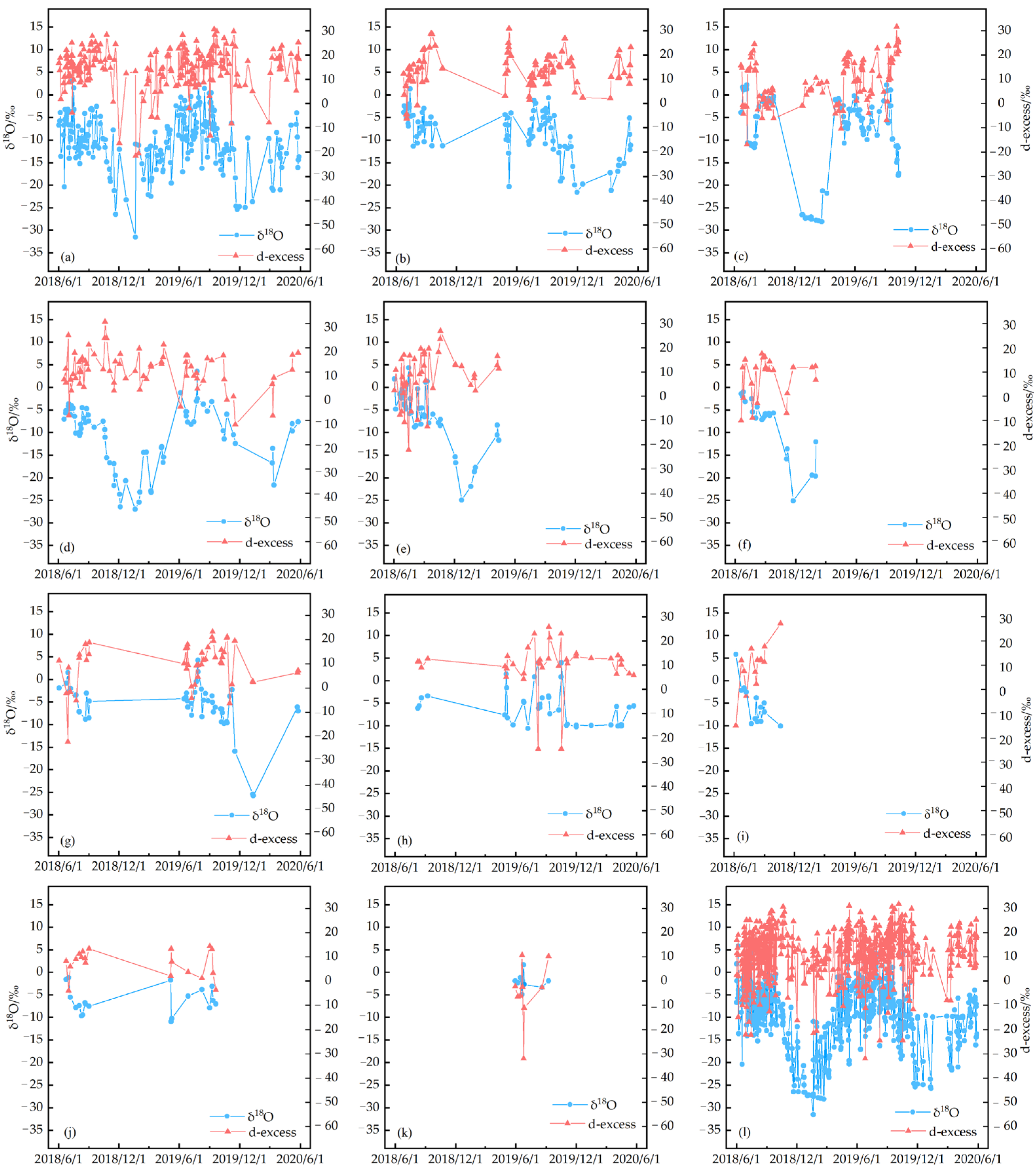
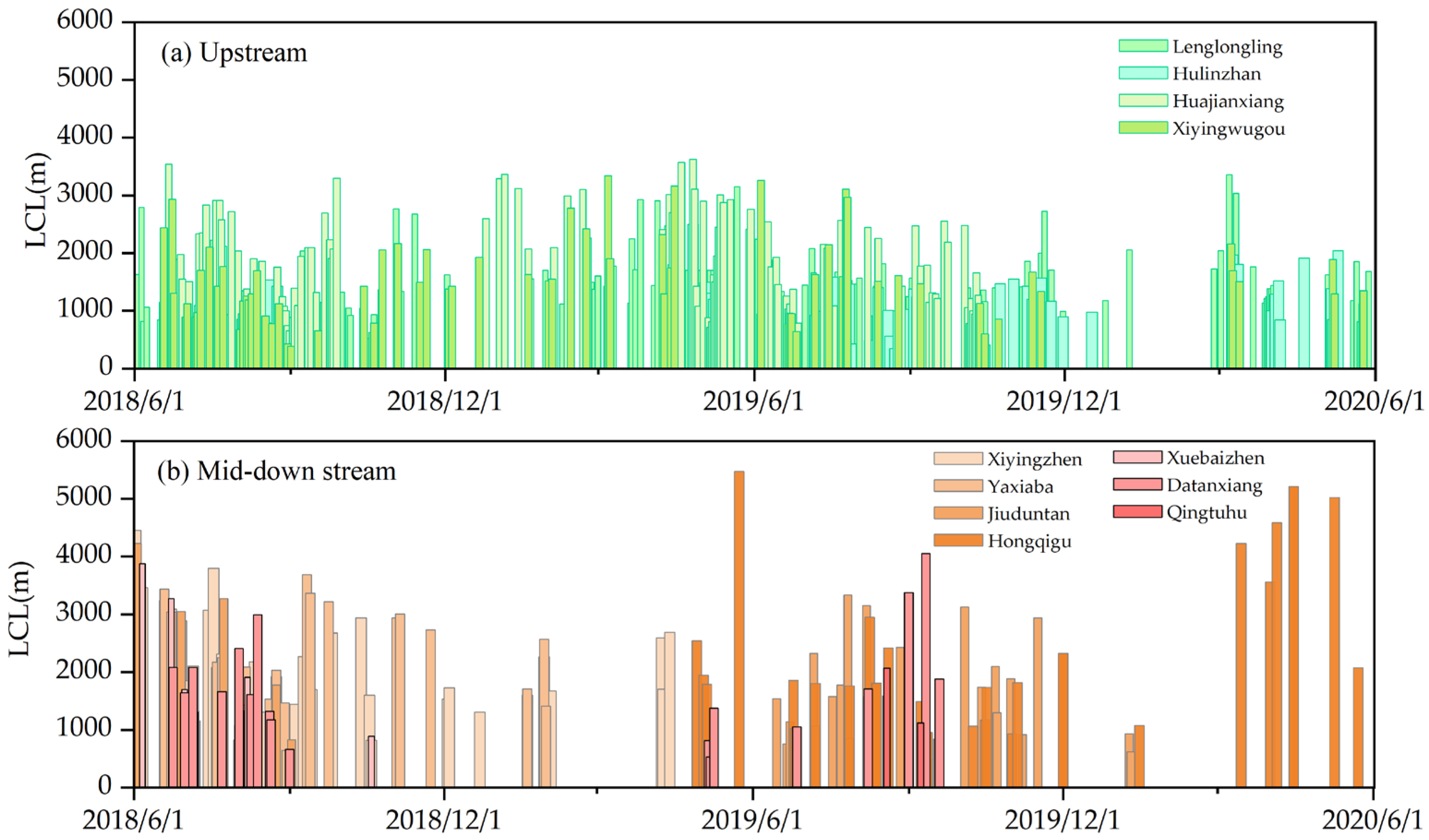
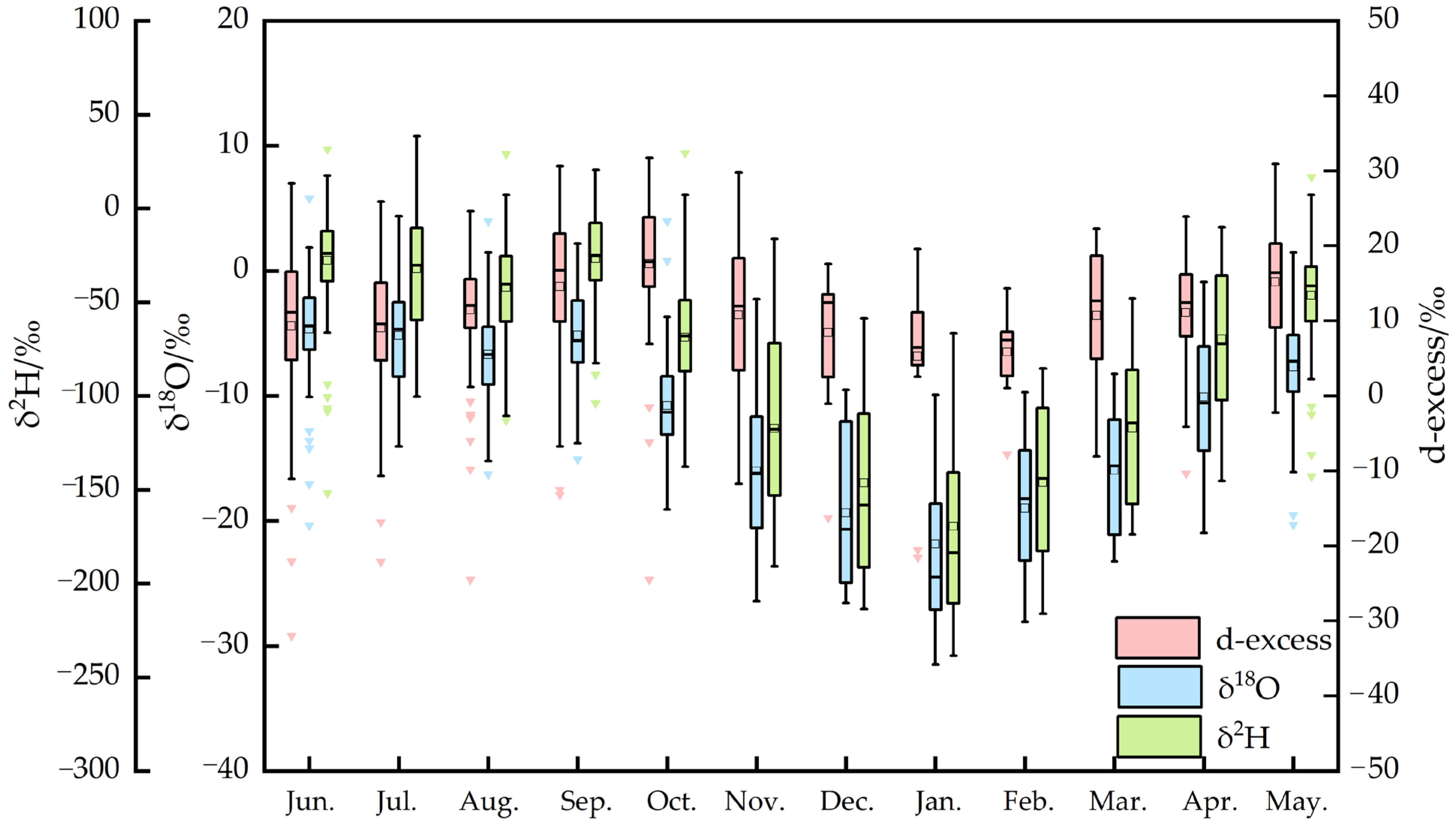
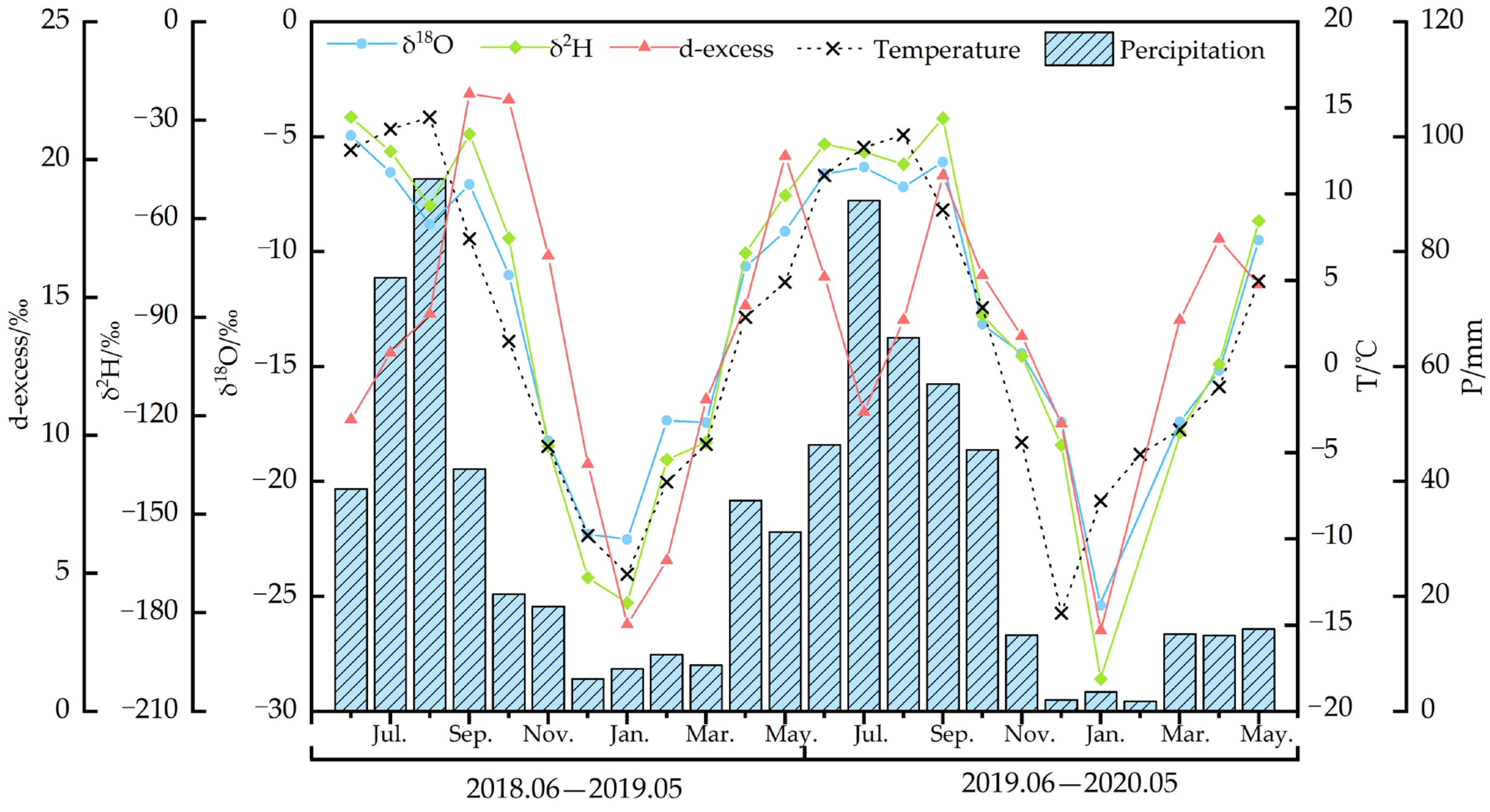
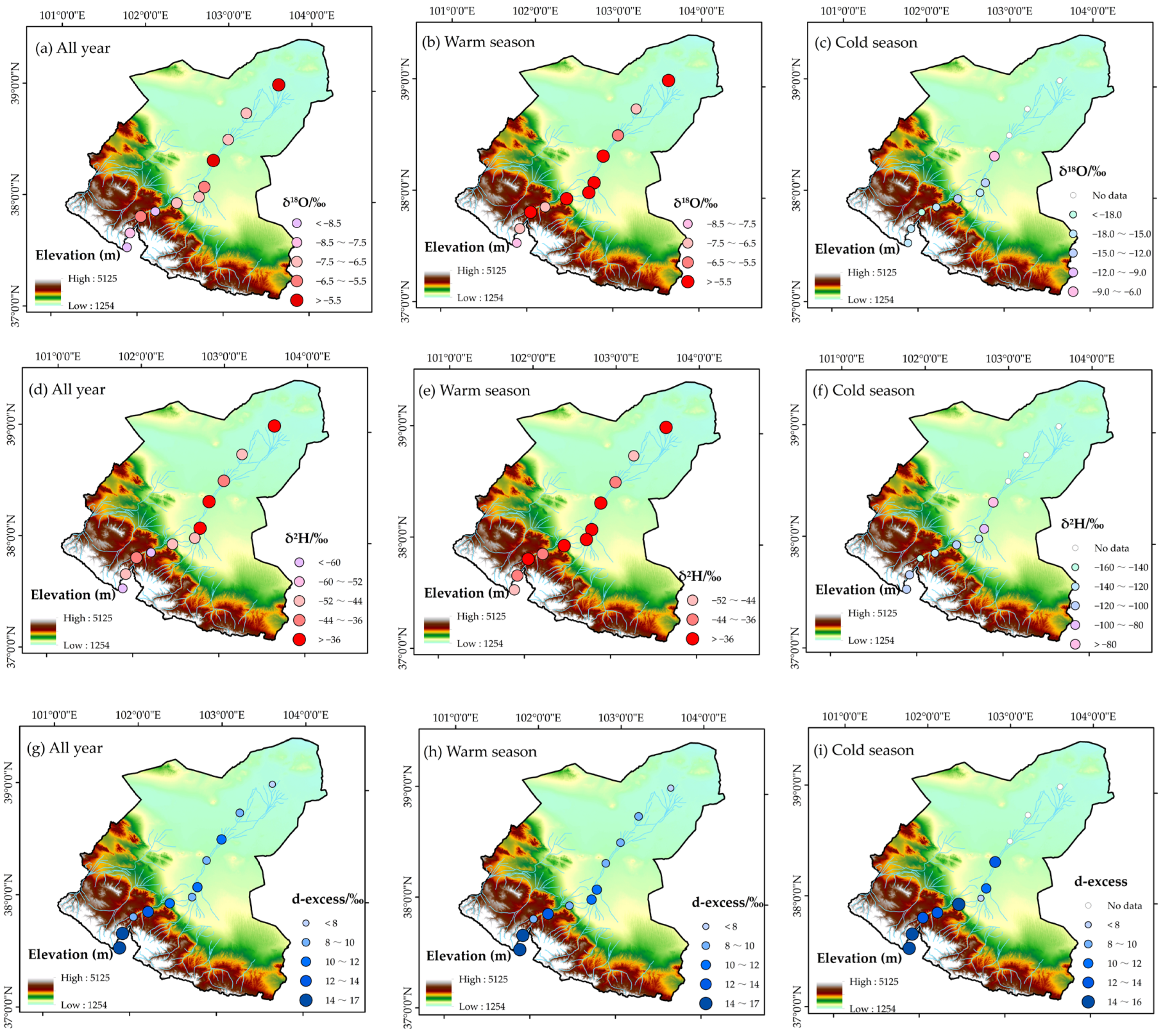
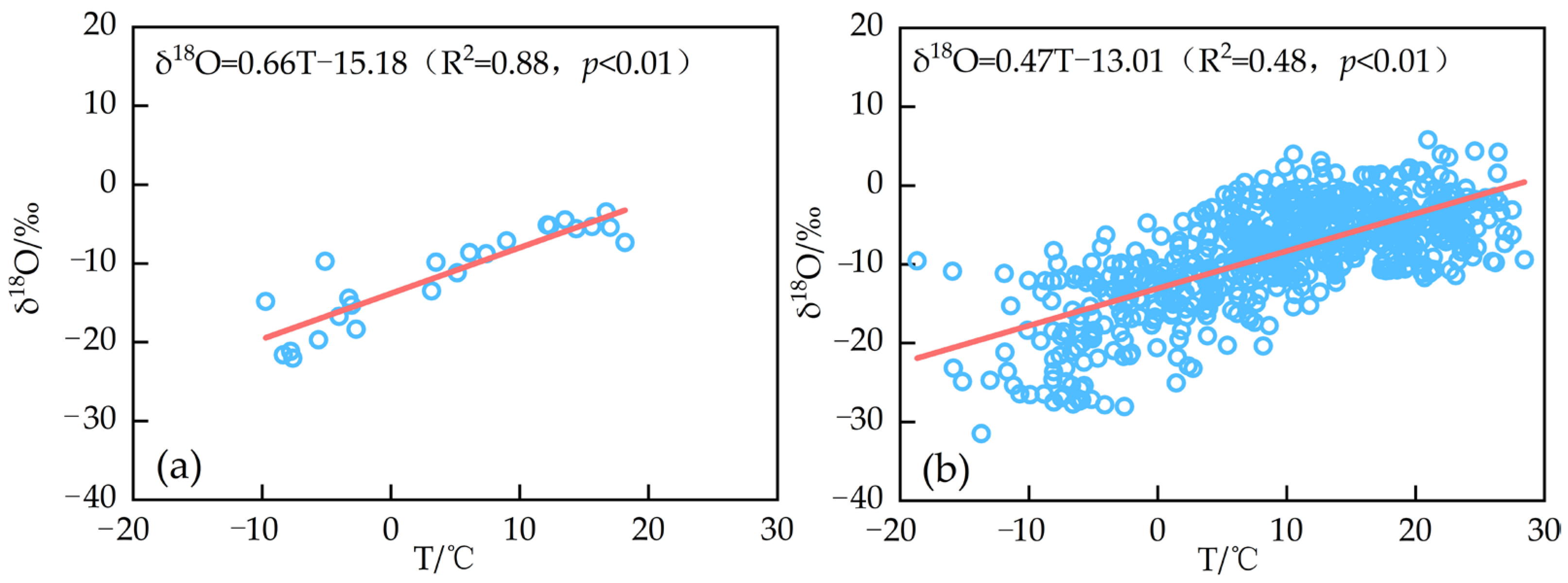

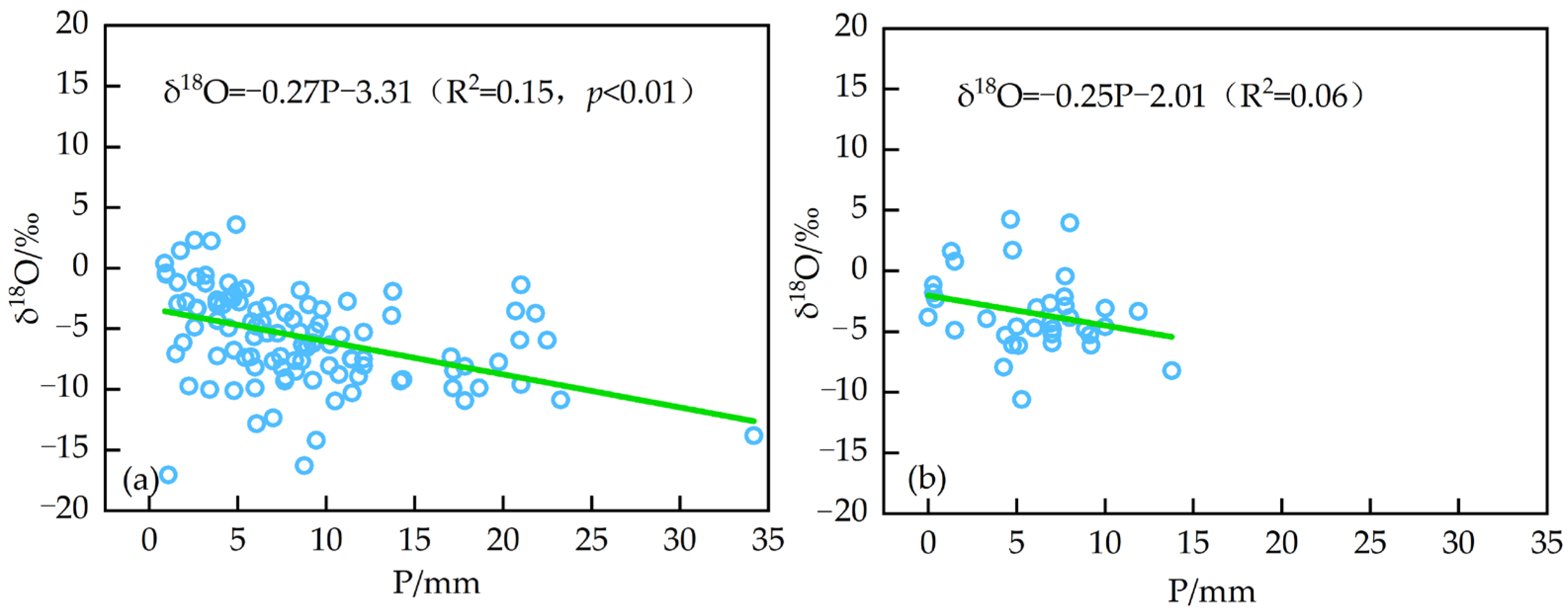
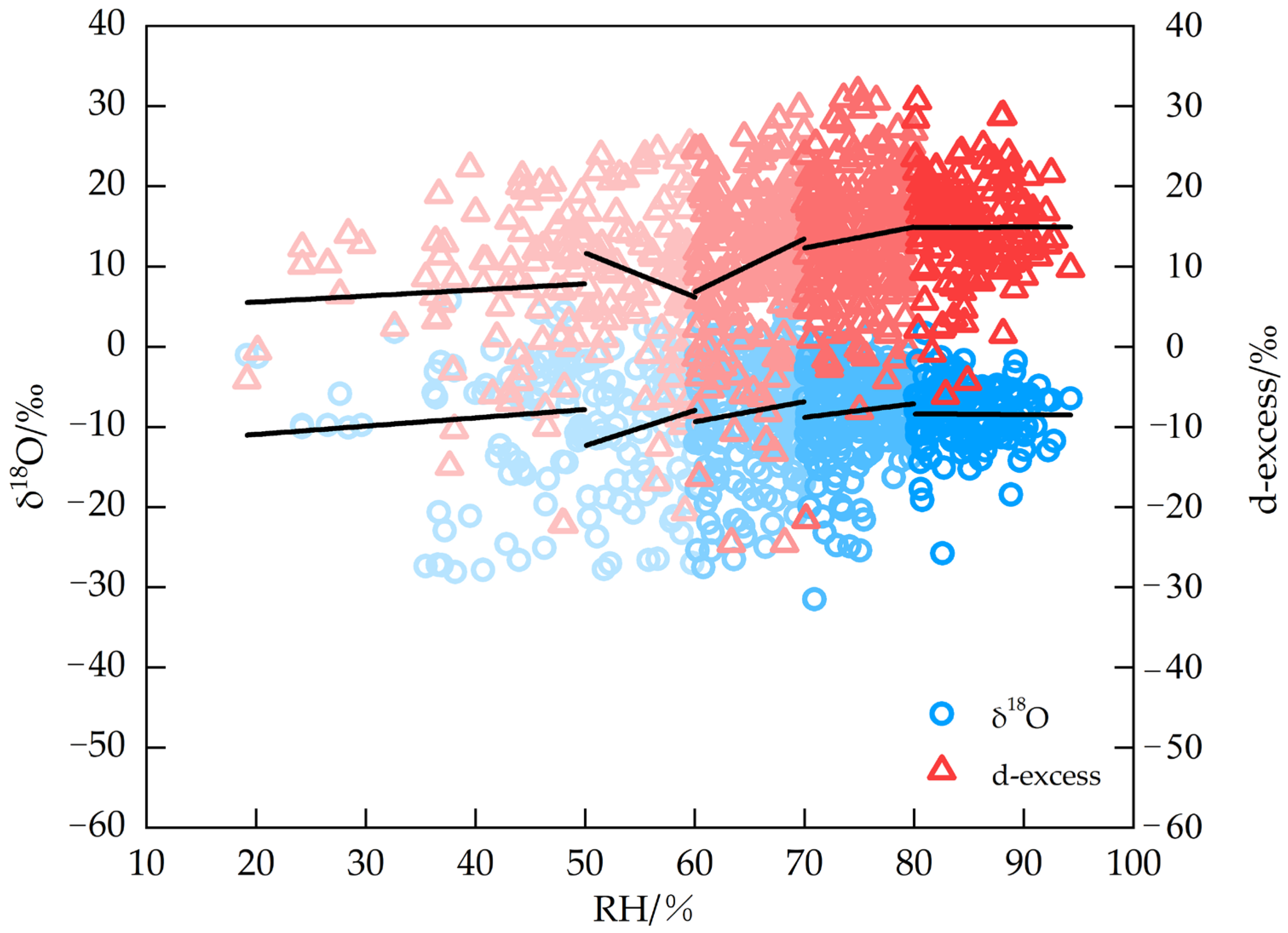
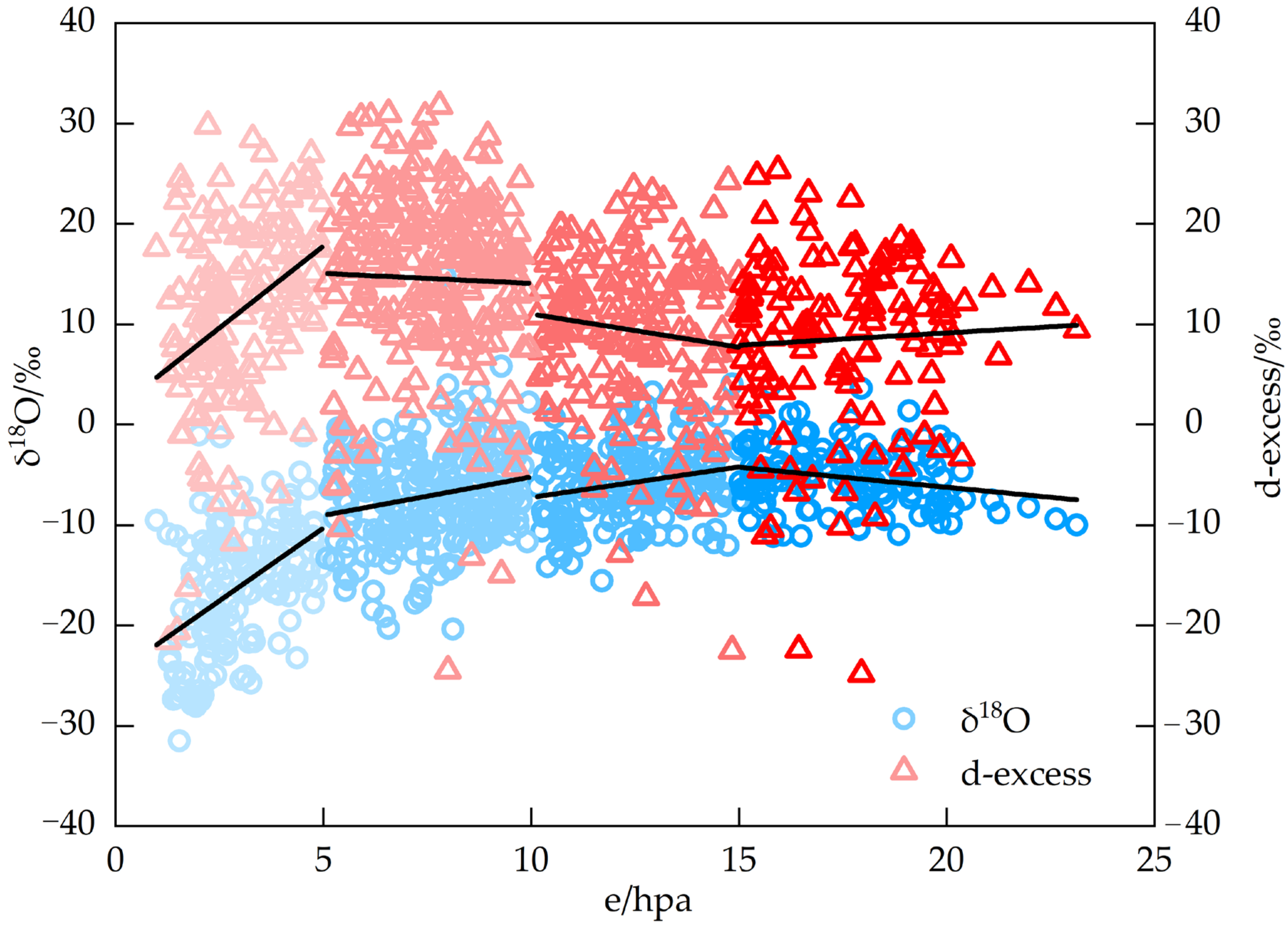
| Sampling Points | Longitude/E | Latitude/N | Elevation/m | Number of Samples | Sampling Period | |
|---|---|---|---|---|---|---|
| Upstream | Lenglongling | 101.86° | 37.56° | 3653 | 224 | June 2018~May 2020 |
| Hulinzhan | 101.89° | 37.69° | 2720 | 90 | June 2018~May 2020 | |
| Huajianxiang | 102.01° | 37.84° | 2324 | 117 | June 2018~October 2019 | |
| Xiyingwugou | 102.18° | 37.89° | 2096 | 69 | June 2018~May 2020 | |
| Midstream | Xiyingzhen | 102.43° | 37.97° | 1748 | 42 | June 2018~April 2019 |
| Yangxiaba | 102.69° | 38.03° | 1489 | 22 | June 2018~January 2019 | |
| Jiuduntan | 102.75° | 38.12° | 1464 | 47 | June 2018~May 2020 | |
| Hongqigu | 102.85° | 38.36° | 1421 | 36 | August 2018~May 2020 | |
| Downstream | Xuebaizhen | 103.02° | 38.55° | 1387 | 13 | June 2018~October 2018 |
| Datanxiang | 103.23° | 38.79° | 1348 | 19 | June 2018~September 2019 | |
| Qingtuhu | 103.61° | 39.05° | 1313 | 9 | May 2019~September 2019 | |
| Region | Number of Samples | Precipitation Weighted Average | LMWL | R2 | |
|---|---|---|---|---|---|
| δ2H/‰ | δ18O/‰ | ||||
| Lenglongling | 224 | −63.7 | −10.0 | δ2H = (8.1 ± 0.1) δ18O + (17.9 ± 1.0) | 0.97 |
| Hulinzhan | 90 | −50.4 | −8.1 | δ2H = (7.8 ± 0.2) δ18O + (12.9 ± 1.4) | 0.97 |
| Huajianxiang | 117 | −40.0 | −6.1 | δ2H = (7.5 ± 0.1) δ18O + (5.9 ± 1.1) | 0.97 |
| Xiyingwugou | 69 | −70.7 | −10.4 | δ2H = (8.0 ± 0.1) δ18O + (11.7 ± 1.5) | 0.98 |
| Xiyingzhen | 42 | −44.3 | −6.8 | δ2H = (7.3 ± 0.3) δ18O + (5.6 ± 2.3) | 0.94 |
| Yangxiaba | 22 | −49.7 | −7.4 | δ2H = (7.8 ± 0.3) δ18O + (6.2 ± 3.0) | 0.96 |
| Jiuduntan | 47 | −35.3 | −5.8 | δ2H = (7.7 ± 0.3) δ18O + (8.0 ± 1.9) | 0.95 |
| Hongqigu | 36 | −28.7 | −4.8 | δ2H = (6.7 ± 0.3) δ18O + (2.8 ± 2.4) | 0.92 |
| Xuebaizhen | 13 | −41.1 | −6.6 | δ2H = (6.1 ± 0.5) δ18O + (−0.7 ± 3.5) | 0.94 |
| Datanxiang | 19 | −47.5 | −7.0 | δ2H = (7.1 ± 0.4) δ18O + (2.4 ± 3.0) | 0.95 |
| Qingtuhu | 9 | −36.8 | −5.4 | δ2H = (6.3 ± 0.6) δ18O + (−2.3 ± 3.3) | 0.88 |
| Upstream | 500 | −55.4 | −8.6 | δ2H = (7.7 ± 0.1) δ18O + (11.4 ± 0.6) | 0.97 |
| Mid-downstream | 188 | −39.8 | −6.2 | δ2H = (7.4 ± 0.1) δ18O + (6.1 ± 1.1) | 0.95 |
| Whole basin | 688 | −51.6 | −8.0 | δ2H = (7.6 ± 0.1) δ18O + (9.8 ± 0.5) | 0.97 |
| Area | Temperature Effect of δ18O (‰/°C) (R2) | Temperature Effect of d-Excess (‰/°C) (R2) | ||||||
|---|---|---|---|---|---|---|---|---|
| <0 °C | 0–10 °C | >10 °C | T | <0 °C | 0–10 °C | >10 °C | T | |
| Upstream | 0.53 (0.12) ** | 0.73 (0.19) ** | −0.06 (0.003) | 0.55 (0.48) ** | 0.55 (0.05) * | −0.34 (0.02) | −0.27 (0.01) | −0.06 (0.003) |
| Mid-downstream | 0.40 (0.02) | 1.86 (0.42) ** | 0.21 (0.06) ** | 0.43 (0.49) ** | 0.38 (0.02) | 1.87 (0.14) | −0.53 (0.05) ** | −0.16 (0.02) * |
| Whole basin | 0.52 (0.11) ** | 0.77 (0.19) ** | 0.07 (0.01) | 0.47 (0.48) ** | 0.54 (0.05) * | −0.26 (0.01) | −0.39 (0.04) ** | −0.15 (0.02) ** |
| Season | Number of Samples | The Amount Effect of δ2H (‰/mm) (R2) | The Amount Effect of δ18O (‰/mm) (R2) | The Amount Effect of d-Excess (‰/mm) (R2) |
|---|---|---|---|---|
| Spring | 120 | 1.64 (0.03) | 0.14 (0.01) | 0.55 (0.10) ** |
| Summer | 335 | −1.57 (0.07) ** | −0.25 (0.09) ** | 0.42 (0.05) ** |
| Autumn | 179 | 1.44 (0.02) | 0.11 (0.01) | 0.52 (0.05) ** |
| Winter | 46 | −2.68 (0.02) | −0.39 (0.02) | 0.46 (0.02) |
| All year | 680 | 1.06 (0.01) ** | 0.08 (0.003) | 0.42 (0.04) ** |
| Area | The Amount Effect of δ2H (‰/mm) (R2) | The Amount Effect of δ18O (‰/mm) (R2) | The Amount Effect of d-Excess (‰/mm) (R2) | |||
|---|---|---|---|---|---|---|
| 0–10 mm | 10–25 mm | 0–10 mm | 10–25 mm | 0–10 mm | 10–25 mm | |
| Upstream | 2.79 (0.01) * | −1.15 (0.01) | 0.26 (0.01) | −0.13 (0.01) | 0.74 (0.03) ** | −0.12 (0.003) |
| Mid-downstream | 0.13 (0.0001) | −0.28 (0.001) | −0.11 (0.002) | −0.12 (0.01) | 0.99 (0.06) ** | 0.67 (0.03) |
| Whole basin | 1.92 (0.01) * | −1.20 (0.01) | 0.14 (0.002) | −0.15 (0.01) | 0.83 (0.04) ** | 0.003 (0.00) |
| Relative Humidity/% | Number of Samples | δ2H vs. RH Slope (R2) | δ18O vs. RH Slope (R2) | d-Excess vs. RH Slope (R2) | Average Temperature/°C | Average Precipitation /mm | Average Water Vapor Pressure /hPa |
|---|---|---|---|---|---|---|---|
| <50 | 79 | 0.9 (0.010) | 0.10 (0.008) | 0.08 (0.003) | 12.27 | 5.45 | 7.41 |
| 50–60 | 81 | 2.97 (0.022) | 0.44 (0.029) | −0.55 (0.030) | 9.40 | 6.00 | 8.15 |
| 60–70 | 182 | 2.68 (0.024) * | 0.25 (0.013) | 0.66 (0.038) ** | 9.04 | 6.24 | 9.20 |
| 70–80 | 198 | 1.63 (0.012) | 0.17 (0.009) | 0.26 (0.009) | 9.45 | 7.46 | 10.07 |
| 80–100 | 133 | −0.07 (−0.008) | −0.01 (−0.008) | 0.003 (−0.008) | 10.19 | 9.37 | 11.15 |
| Vapor Pressure/hPa | Number of Samples | δ2H vs. Vapor Pressure Slope (R2) | δ18O vs. Vapor Pressure Slope (R2) | d-Excess vs. Vapor Pressure Slope (R2) | Average Temperature /°C | Average Precipitation /mm | Average RH /% |
|---|---|---|---|---|---|---|---|
| 0–5 | 156 | 26.46 (0.27) ** | 2.9 (0.22) ** | 3.26 (0.13) ** | −3.22 | 5.12 | 59.93 |
| 5–10 | 235 | 5.93 (0.05) ** | 0.77 (0.04) ** | −0.2 (0.001) | 8.41 | 6.68 | 70.31 |
| 10–15 | 157 | 4.2 (0.04) * | 0.61 (0.04) ** | −0.66 (0.01) | 15.88 | 8.64 | 70.29 |
| >15 | 125 | −2.95 (0.05) ** | −0.4 (0.04) ** | 0.25 (0.003) | 21.07 | 8.30 | 71.33 |
Disclaimer/Publisher’s Note: The statements, opinions and data contained in all publications are solely those of the individual author(s) and contributor(s) and not of MDPI and/or the editor(s). MDPI and/or the editor(s) disclaim responsibility for any injury to people or property resulting from any ideas, methods, instructions or products referred to in the content. |
© 2023 by the authors. Licensee MDPI, Basel, Switzerland. This article is an open access article distributed under the terms and conditions of the Creative Commons Attribution (CC BY) license (https://creativecommons.org/licenses/by/4.0/).
Share and Cite
Lan, X.; Jia, W.; Zhu, G.; Zhang, Y.; Yu, Z.; Luo, H. Spatial and Temporal Variation Characteristics of Stable Isotopes in Precipitation and Their Relationships with Meteorological Factors in the Shiyang River Basin in China. Water 2023, 15, 3836. https://doi.org/10.3390/w15213836
Lan X, Jia W, Zhu G, Zhang Y, Yu Z, Luo H. Spatial and Temporal Variation Characteristics of Stable Isotopes in Precipitation and Their Relationships with Meteorological Factors in the Shiyang River Basin in China. Water. 2023; 15(21):3836. https://doi.org/10.3390/w15213836
Chicago/Turabian StyleLan, Xin, Wenxiong Jia, Guofeng Zhu, Yue Zhang, Zhijie Yu, and Huifang Luo. 2023. "Spatial and Temporal Variation Characteristics of Stable Isotopes in Precipitation and Their Relationships with Meteorological Factors in the Shiyang River Basin in China" Water 15, no. 21: 3836. https://doi.org/10.3390/w15213836




